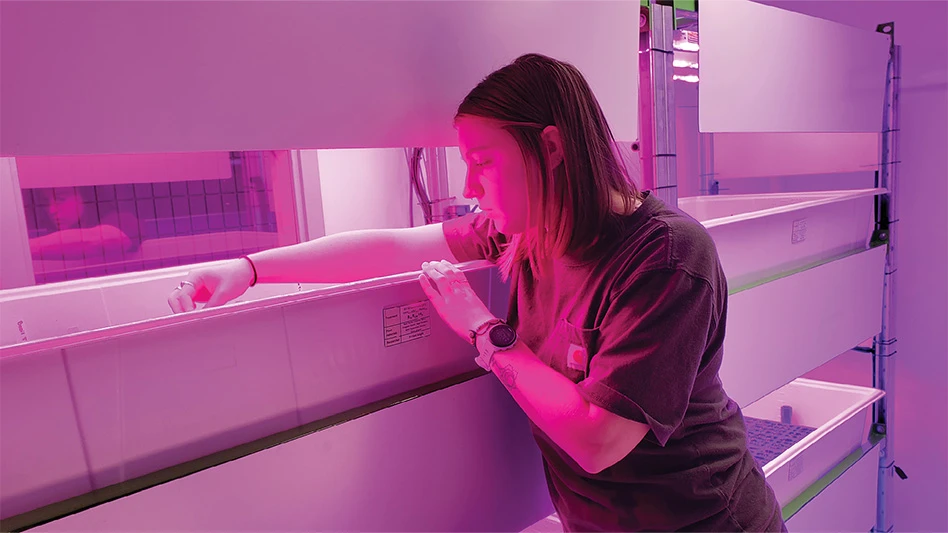|
.jpg) When a grower sees the paint peeling off of the 100-plus-year-old cypress wood bars in his pipe frame greenhouse, three options may cross his mind: 1) Replace the bars or the greenhouse at a tremendous cost; 2) put off the project and risk structural failure leading to more costs; or 3) roll up his sleeves and get busy. When a grower sees the paint peeling off of the 100-plus-year-old cypress wood bars in his pipe frame greenhouse, three options may cross his mind: 1) Replace the bars or the greenhouse at a tremendous cost; 2) put off the project and risk structural failure leading to more costs; or 3) roll up his sleeves and get busy.
The third option is easier said than done. Safely removing the glass panels, then stripping, cleaning and painting about 150 roof bars per 100 feet of greenhouse is a daunting task. But it's a task worth tackling. Growers who properly manage their greenhouses know that with regular maintenance, they can probably get another 100 years of production out of their structures.
Maintenance Benefits
As labor intensive as some greenhouse maintenance tasks can be, I always stress performing these activities. A well-planned maintenance program for a greenhouse operation can benefit the business in multiple ways, including:
- Increases efficiencies.
- Increases useful life of structures.
- Improves insurability of the operation, which reduces overhead.
- Provides optimum growing conditions.
All greenhouse operations need to consider a maintenance program, regardless of size or geographic location. This includes both reactive maintenance resulting from deterioration or damage to structural components and preventive maintenance that helps avoid future problems and extends the life of structures. A maintenance program is critical to the short- and long-term success of your greenhouse business.
Deterioration Factors
Many factors can affect the condition of a greenhouse structure and its cladding (coverings). These include, but are not limited to, ultraviolet light, water and loading (wind and snow).
 Ultraviolet Light Ultraviolet Light
While most greenhouse coverings contain ultraviolet radiation inhibitors to impede degradation of the glazing material, the inhibitors have a limited period of effectiveness. Ultimately UV light breaks down the cladding. The time frame for this process varies by the type of covering and the geographic location. Light transmission into the greenhouse is affected by this degradation process. It's also important to note that the cladding can become brittle and more susceptible to wind and hail damage.
Water
Water is abundant in the greenhouse environment. While plants thrive in these conditions, over time water has a negative effect on the structure's metal and wood components. Preventive maintenance can resolve this issue.
Eliminate any area where water stands around load bearing members, specifically gutter posts or columns. This can be accomplished by building up the area around the gutter posts/columns slightly with soil, placing rock in the area or pouring concrete at a grade to ensure that water is channeled away from the structural components. Typically, at the point where the gutter post enters the ground is where most deterioration issues related to water occur.
The combination of water and oxygen causes rusting of metal components that do not have a protective coating. Rust on load bearing members or at points of connection can cause major issues. Rust begins to form on a structure's metal components as the result of oxidation. This is the chemical reaction between the alloys in the metal components, oxygen and water.
If rust is found on a metal component, the severity of the deterioration should be evaluated. It needs to be determined if the integrity of the component has been compromised or if the rust is superficial. If the deterioration is a surface issue, remove the rust with a wire brush and seal with a protective coating, if necessary. If the component's integrity has been compromised, consider making a replacement or adding a comparable component to share the load.
Another consideration with steel gutter posts is the collection of water inside the post cavity. This water accumulation is typically caused by an improper seal at the gutter or connection to the arch in combination with condensation. This can lead to the post, regardless of galvanization, deteriorating from the inside out, or the post failing during the winter months due to freeze/thaw issues.
While most greenhouses built with wood components are constructed of materials that are resistant to water, over time, without proper maintenance, these components can ultimately succumb to the devastating effects of water. Wood components should be checked regularly for water saturated areas. If areas of saturation are found, attempt to eliminate the water or regularly treat the area affected to protect the wood.
Deterioration of wood components can cause loose connections. For example, water can leak at the gutter line area, collecting at the connection point of the wood bars. Water, over time, can cause wood bars to rot out at the connection points. This is evidenced by the ability to push the wood bar freely from the gutter line. This deterioration can contribute to structural failure and/or cladding issues, such as glass breakage.
Wind and Snow
Loading from wind and snow can also lead to structural damage. Snow loads result in continuous stress on load bearing components. Wind loads cause movement within a structure. Stress and movement in a structure can cause loose connections, structural deflection and or failure – all of which should be addressed immediately if found.
Planning a Program
It is understood that maintenance is a daunting task. In speaking with growers and contractors over the years, I've seen that a reasonable, concise and regularly scheduled plan can keep greenhouse structures in good operating condition.
Consider the following when setting up a maintenance program:
- Designate and train employees to identify maintenance issues.
- Complete regular structural evaluations to identify problem areas.
- Schedule regular maintenance during down times to repair the issues found in evaluations.
- Keep accurate records that document the maintenance performed.
- Know the warranties applicable to the materials purchased, and maintain an appropriate filing system for relevant paperwork.
- Contact contractors and suppliers to see if they offer a maintenance program.
Maintenance Checklist
A sample checklist for a maintenance walk through might include:
- Check the exterior of the structure for cladding issues (slipped glass, deflated polyethylene film, loose fasteners, etc.)
- Review the age of the cladding to determine if its life expectancy has been exceeded.
- Check the exterior of structures for any wash out around load bearing members.
- Check load-bearing structural members for rust.
- Check the structure to ensure that it is plumb – no shifting and/or deflection.
- Identify areas where there is standing water and/or evidence of the presence of water.
- Ensure that all greenhouse structure and covering connections are secure.
- Ensure that all vents close completely.
- Check seasonal equipment to ensure it is operating properly.
Long Term Benefits
Ultimately a well maintained structure is stronger and more efficient. But there are other benefits that are achieved through a maintenance program.
Maintenance is one aspect of the evaluation process when considering the insurability of a greenhouse. Greenhouses were engineered to withstand wind and snow loads up to a certain level, assuming the structural components are in good working condition. Deterioration of components such as gutters, purlins and other load bearing members provide weak points where a failure can occur under load.
Poor maintenance can also signal unsafe working conditions, which would make the risk less appealing. The condition of the property can affect the insurability of a structure and potentially the price paid for insurance coverage.
Aside from insurability, a grower doesn't want to deal with the headache and cost of losing a poly roof in the spring or suffering the collapse of structure under minimum loading when poinsettias are ready to be shipped. A regular maintenance program can reduce these risks.
Efficiencies and productivity can be maximized in a well-maintained structure. From light transmission to energy savings, a well maintained greenhouse contributes to obtaining maximum ROI from employees, equipment and facilities.
If you currently don't have a greenhouse maintenance program in place, ask your insurance provider for suggestions on how your company can get started.
Eric Jones, AIC, is claim representative - property claims at Hortica Insurance & Employee Benefits, (618) 655-1873, ejones@hortica-insurance.com;
www.hortica-insurance.com.
|

.jpg) When a grower sees the paint peeling off of the 100-plus-year-old cypress wood bars in his pipe frame greenhouse, three options may cross his mind: 1) Replace the bars or the greenhouse at a tremendous cost; 2) put off the project and risk structural failure leading to more costs; or 3) roll up his sleeves and get busy.
When a grower sees the paint peeling off of the 100-plus-year-old cypress wood bars in his pipe frame greenhouse, three options may cross his mind: 1) Replace the bars or the greenhouse at a tremendous cost; 2) put off the project and risk structural failure leading to more costs; or 3) roll up his sleeves and get busy.  Ultraviolet Light
Ultraviolet Light 




